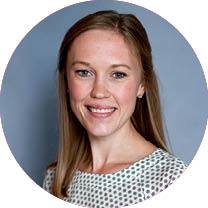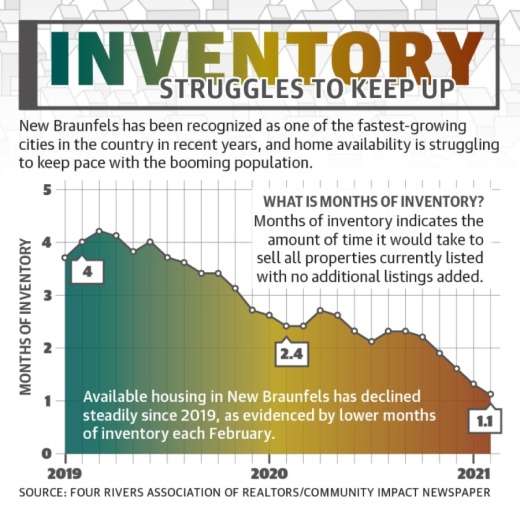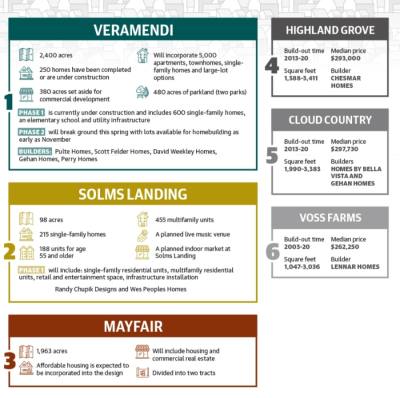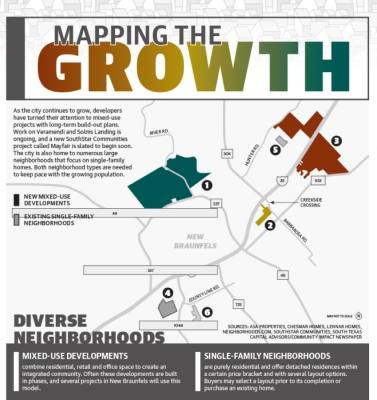A rapidly growing population, historically low interest rates and changing consumer needs have shifted the New Braunfels housing market into one of the most competitive in the area.
Between 2014 and 2019, U.S Census Bureau data states the population of New Braunfels grew by 46.99%, from 61,712 residents to 90,710, and the bureau named the city as one of the fastest growing cities in the nation in 2020.
As the city has expanded, the supply of existing and new homes for sale has struggled to keep pace with demand, as evidenced by a steady decline in months of inventory in the market according to area realtors.
Months of inventory indicates the amount of time it would take to sell all properties currently listed with no additional listings added, said Patricia Fernandez, 2021 president of Four Rivers Association of Realtors. When the
demand for homes outpaces active listings, Fernandez said months of inventory decline and prices rise as the market becomes a seller’s market.
In February, the New Braunfels area had 1.1 months of inventory according to data collected by the Texas Real Estate Research Center. Since November of 2020, the market has consistently reported less than two months of inventory, and the area has not had more than four months of inventory since June of 2019.
“A normal, healthy inventory for real estate in any market is about six months worth,” Fernandez said. “COVID[-19] happened, and that just threw everything into havoc.”
According to local realtors, city staff and development professionals, the declining months of inventory in New Braunfels is a multifaceted issue. Complications brought about by the ongoing COVID-19 pandemic, as well as skyrocketing demand, materials shortages and evolving expectations from homeowners have resulted in a more diversified residential landscape.
As trends that include changing work environments and rapidly fluctuating consumer needs continue to develop and shift, area experts maintain the local residential market will do the same.
“A lot of people are moving because they’re working from home and they’re realizing, ‘I can work from anywhere, I don’t have to stay where I was,’” said Jessica Harris, marketing coordinator for Scott Felder Homes. “When everybody wants something, the supplies can never keep up.”
Builders are struggling to keep up
Residential developments in New Braunfels have added hundreds of single-family homes to the market in recent years with more than 1,600 permits issued in 2020 alone according to Jeff Jewell, director of economic and community development in New Braunfels.
Despite a large number of projects underway, supply has remained low as local builders are facing shortages of lumber, appliances and other raw materials as a result of the coronavirus pandemic and its impact on suppliers.
“The lumber prices are continuing to rise due to the high demand,” said Harris. “We're not even showcasing the homes anymore that haven't been framed because the prices are changing daily on the material costs.”
In February Scott Felder Homes stopped listing homes on its website that were not fully framed due to constantly shifting prices, Harris said.
The company is building single-family homes in the Veramendi development located north of Loop 337 and will contribute to the 600 properties planned for the first phase of the project.
Homes routinely sell within hours or days of becoming available, Harris said, but many buyers will still have to wait up to a year before moving in.
One of the driving factors for buyers in New Braunfels is the need for additional space, as many people are now working from home or moving away from larger cities, according to Yvonne Hoffmann, realtor with Reliance
Residential Realty in New Braunfels. This recent trend has led to some people selling their homes in favor of larger properties.
“People realize now what they need out of their home itself,” Hoffmann said
However, because of the low inventory across the market, Hoffmann said that sellers may delay their decision to sell or be prepared to rent temporarily while they wait to purchase their next home.
More diverse housing options are needed
Buyers are also experiencing a more competitive market as sale prices increase and multiple offers are made on each property, Fernandez said.
In February, the median sale price for a home in New Braunfels was $279,450, up 12.9% from February 2020, when the median sale price was $246,000.
“As things get more expensive, there’s a need for more diverse housing such as more townhomes or condos,” Fernandez said. “We need to have that diversity, I feel, to kind of help fill in some of these gaps in the housing.”
While single-family, detached homes remain the primary new home type in New Braunfels, developers of large projects around the city have incorporated multi-family units into site plans.
One such project is the Veramendi development, which was first conceptualized in 2008 and has an estimated completion timeline of 2035.
Once complete, the 2,400 acre Veramendi development will include 5,000 housing units, several commercial development sites, a hospital campus and 480 acres of parkland, according to Max Harford, the development manager with ASA Properties who oversees the Veramendi development.
“Single-family is no doubt the most important element of Veramendi. It's what makes the project what it is,” Harford said, but stipulated Veramendi will also eventually have opportunities for clients to move into apartments and townhomes.
In its first phase, the development has focused on building single-family homes and developing infrastructure that will be needed for continued development, Harford said.
Phase two, which is anticipated to break ground later this spring, will include smaller homes priced in the mid $200,000 range, as well as 50 acres of commercial development.
“[Veramendi] is heavily residential, but there is a mixed-use component to it to grow the local economy,” Harford said. “Integrating both that commercial component, and the residential component into what's really the anchor of the project, our parks and open space, is a huge design objective for us.”
Mixed-use developments grow in popularity
In addition to Veramendi, several other mixed-use developments are either currently underway or expected to break ground soon in New Braunfels, including Solms Landing near Creekside Crossing.
The 93-acre project was first proposed in 2018 with the goal of providing a multigenerational, mixed-use community that would incorporate several housing styles, retail options and office space.
“Our goal with the development was to create a more integrated, mixed-use development,” said James Mahan, principal at South Texas Capital Advisors and concept developer for the project.
Construction on the first 60 single-family homes is anticipated to begin this spring, followed by work on a two-story commercial neighborhood set to begin later this summer, Mahan said. }
The development will also incorporate Class A office space in order to attract higher-paying jobs, a component that Mahan said aligns with the city’s 2017 Economic Development Strategic Plan.
Included in the plan is a goal to bring more than 300,000 square feet of Class A office space over five years in order to attract more companies to New Braunfels.
Though commercial real estate and office space took a hit during the coronavirus pandemic, developers such as Mahan believe that opportunities in smaller cities will become more attractive to companies looking to move operations closer to where their employees live.
“In our opinion, when people do start talking about office spaces again, I think that they're going to be looking at areas like New Braunfels a lot harder than they probably were before,” Mahan said. “Do you really need to pay top market rents and be in downtown Austin if you're going to have your employees working from home one or two or three days a week?”
Veramend and Solms Landing will soon be joined by a SouthStar Communities project called Mayfair, all of which will follow the mixed-use model of incorporating varying housing types with retail and office spaces.
Though the projects are anticipated to bring needed housing to the community, the lack of available housing is likely to continue for some time.
“Development timelines are naturally long. There's just a lot of conceptual and technical planning that goes into making this a reality,” Harford said. “As much as we wish we could move quicker, we've got to move at the time that makes sense for the opportunities in front of us.”
As the city continues to grow and large-scale projects aim to bring more job opportunities to the areas, builders will likely continue to struggle to keep up with demand, Fernandez said.
“We’ve been in a vicious cycle right now, and because of that, it's been hindering the building, and the building just has not been able to keep up with the demand.” Fernandez said. “Jobs bring people, and then people need housing.”








